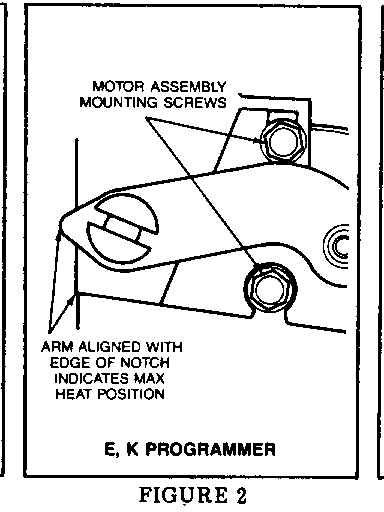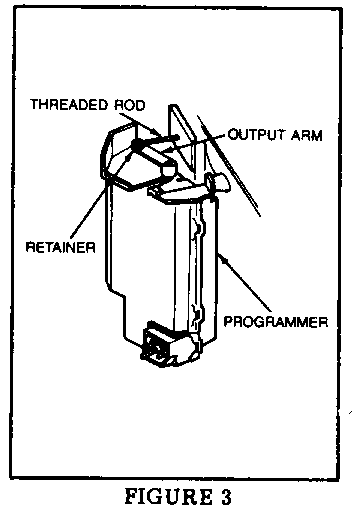ECC PROGRAMMER MOTOR CLICKING DIAGNOSIS/REPLACE PROCEDURE

ECC CLICKING PROGRAMMER AND PROGRAMMER MOTOR REPLACEMENT
A continuous clicking or ratcheting sound originating from the IP area on 1980-1982 "E" and "K" and 1981-1982 "C" and "D" Cadillacs may be caused by the gear train in the ECC programmer motor. This bulletin outlines a service procedure for diagnosing and replacing the programmer motor separately from the programmer to correct noise or other programmer motor related conditions. Previously published service procedures required complete programmer replacement to correct a programmer motor related condition.
Service Procedure
1. Remove the glove box liner.
2. Set the temperature on the control panel to 900. Allow one or two minutes for the programmer arm to travel to its maximum heat position (refer to Figures 1 and 2).
3. Disconnect the threaded rod attached to the air mix door from the plastic retainer on the output arm by prying on the rod with a screwdriver (refer to Figure 3).
NOTICE: Exerting excessive force on the programmer arm can cause internal damage to programmer motor gear train.
4. Check the air mix door for free travel (push the threaded rod to move the door to the maximum A/C position and check for possible binding). If binding occurs, repair of the air mix door in heating and A/C module will be required.
5. Preload the air mix door in the maximum heat position by pulling the threaded rod to ensure a door seal. The programmer output arm should be aligned with the arrow on the "C" and "D" programmer case or notch on the "E" and "K" programmer case (refer to Figures 1 and 2). If the output arm is not aligned as described above, replace motor as described in steps 8-11.
6. Snap the threaded rod into the plastic retainer on programmer arm. Do this carefully to avoid changing the programmer arm to air mix door position.
7. Set the temperature setting on the control panel for 600; the output arm should travel freely and at a uniform speed to maximum cold position. If the motor stops before reaching the maximum cold position or if there is a hesitation and a ratcheting sound, proceed with programmer motor assembly replacement outlined in steps 8-11. When the ignition is first turned on, the programmer arm will momentarily hesitate, move in one direction, and then the other. At the same time, vacuum solenoids will engage, producing a clicking sound. This is NORMAL.
8. Remove programmer from the car as described in the Cadillac Service Information Manual.
9. Disassemble the programmer and replace the motor.
a. Remove the plastic cover from the "C" and "D" programmer (refer to Figures 1 and 2). Remove the cardboard insert from the "E" and "K" programmer.
b. Locate wires going from the motor assembly to the circuit board and disconnect at the connector on the circuit board.
C. Remove the two screws holding the motor assembly to the programmer (refer to Figure 2).
d. Install a new motor assembly, using the listed part numbers:
16008996 E,K (Curved Arm) 16012468 C,D (Straight Arm)
e. Connect the wires to the circuit board making certain that the wires do no bind against armature shaft of motor.
f. Reinstall plastic cover or cardboard insert.
10. Reinstall programmer in car.
11. Perform steps 2 through 7. If the motor movement is still not as described in step 7, replace the programmer; install the original motor back in the inoperative programmer and return the inoperative programmer for repair.
12. Install the glove box liner.
For warranty purposes, use Operation No. D0770, "ECC Programmer - R&R", at .6 hour for "C/D" and .8 hour for "E/K". This time allowance includes an additional .2 hour for motor R&R or replace.



General Motors bulletins are intended for use by professional technicians, not a "do-it-yourselfer". They are written to inform those technicians of conditions that may occur on some vehicles, or to provide information that could assist in the proper service of a vehicle. Properly trained technicians have the equipment, tools, safety instructions and know-how to do a job properly and safely. If a condition is described, do not assume that the bulletin applies to your vehicle, or that your vehicle will have that condition. See a General Motors dealer servicing your brand of General Motors vehicle for information on whether your vehicle may benefit from the information.
